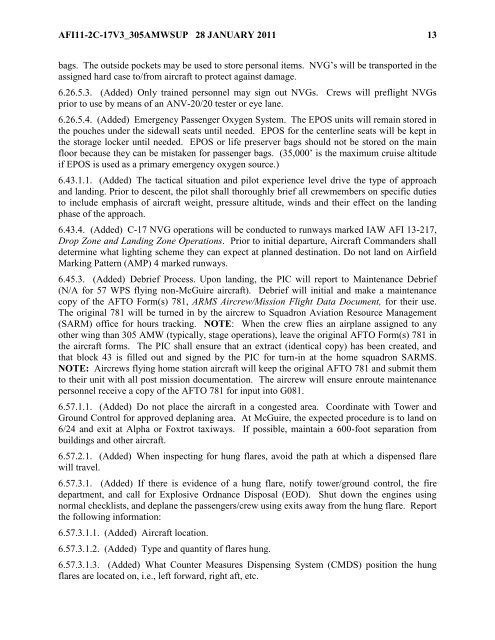BY ORDER OF THE COMMANDER 305TH AIR MOBILITY WING ...
BY ORDER OF THE COMMANDER 305TH AIR MOBILITY WING ...
BY ORDER OF THE COMMANDER 305TH AIR MOBILITY WING ...
Create successful ePaper yourself
Turn your PDF publications into a flip-book with our unique Google optimized e-Paper software.
AFI11-2C-17V3_305AMWSUP 28 JANUARY 2011 13<br />
bags. The outside pockets may be used to store personal items. NVG’s will be transported in the<br />
assigned hard case to/from aircraft to protect against damage.<br />
6.26.5.3. (Added) Only trained personnel may sign out NVGs. Crews will preflight NVGs<br />
prior to use by means of an ANV-20/20 tester or eye lane.<br />
6.26.5.4. (Added) Emergency Passenger Oxygen System. The EPOS units will remain stored in<br />
the pouches under the sidewall seats until needed. EPOS for the centerline seats will be kept in<br />
the storage locker until needed. EPOS or life preserver bags should not be stored on the main<br />
floor because they can be mistaken for passenger bags. (35,000’ is the maximum cruise altitude<br />
if EPOS is used as a primary emergency oxygen source.)<br />
6.43.1.1. (Added) The tactical situation and pilot experience level drive the type of approach<br />
and landing. Prior to descent, the pilot shall thoroughly brief all crewmembers on specific duties<br />
to include emphasis of aircraft weight, pressure altitude, winds and their effect on the landing<br />
phase of the approach.<br />
6.43.4. (Added) C-17 NVG operations will be conducted to runways marked IAW AFI 13-217,<br />
Drop Zone and Landing Zone Operations. Prior to initial departure, Aircraft Commanders shall<br />
determine what lighting scheme they can expect at planned destination. Do not land on Airfield<br />
Marking Pattern (AMP) 4 marked runways.<br />
6.45.3. (Added) Debrief Process. Upon landing, the PIC will report to Maintenance Debrief<br />
(N/A for 57 WPS flying non-McGuire aircraft). Debrief will initial and make a maintenance<br />
copy of the AFTO Form(s) 781, ARMS Aircrew/Mission Flight Data Document, for their use.<br />
The original 781 will be turned in by the aircrew to Squadron Aviation Resource Management<br />
(SARM) office for hours tracking. NOTE: When the crew flies an airplane assigned to any<br />
other wing than 305 AMW (typically, stage operations), leave the original AFTO Form(s) 781 in<br />
the aircraft forms. The PIC shall ensure that an extract (identical copy) has been created, and<br />
that block 43 is filled out and signed by the PIC for turn-in at the home squadron SARMS.<br />
NOTE: Aircrews flying home station aircraft will keep the original AFTO 781 and submit them<br />
to their unit with all post mission documentation. The aircrew will ensure enroute maintenance<br />
personnel receive a copy of the AFTO 781 for input into G081.<br />
6.57.1.1. (Added) Do not place the aircraft in a congested area. Coordinate with Tower and<br />
Ground Control for approved deplaning area. At McGuire, the expected procedure is to land on<br />
6/24 and exit at Alpha or Foxtrot taxiways. If possible, maintain a 600-foot separation from<br />
buildings and other aircraft.<br />
6.57.2.1. (Added) When inspecting for hung flares, avoid the path at which a dispensed flare<br />
will travel.<br />
6.57.3.1. (Added) If there is evidence of a hung flare, notify tower/ground control, the fire<br />
department, and call for Explosive Ordnance Disposal (EOD). Shut down the engines using<br />
normal checklists, and deplane the passengers/crew using exits away from the hung flare. Report<br />
the following information:<br />
6.57.3.1.1. (Added) Aircraft location.<br />
6.57.3.1.2. (Added) Type and quantity of flares hung.<br />
6.57.3.1.3. (Added) What Counter Measures Dispensing System (CMDS) position the hung<br />
flares are located on, i.e., left forward, right aft, etc.
















